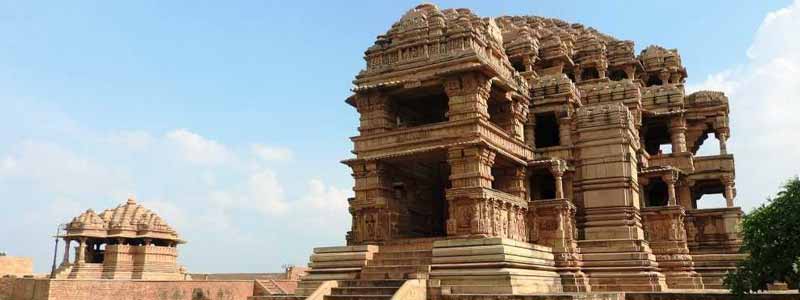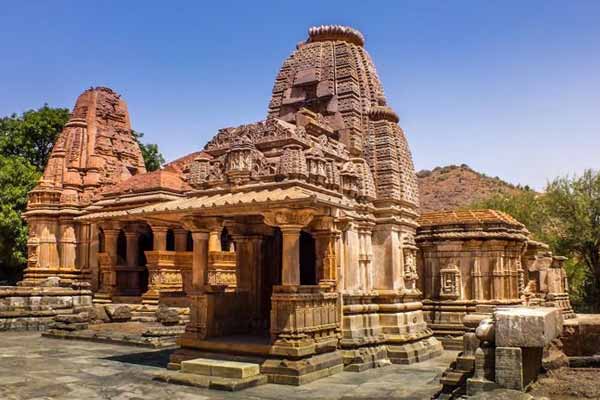Sahastra Bahu Temple Udaipur, also known as the Sas-Bahu Temple, is a magnificent Hindu temple located in the city of Udaipur, Rajasthan, India. Situated amidst the scenic Aravalli hills, this ancient temple stands as a testimony to the rich cultural and architectural heritage of the region.
The Sahastra Bahu Temple is an architectural marvel dating back to the 10th century, belonging to the Nagara style of temple architecture. It is dedicated to Lord Vishnu and is renowned for its intricate carvings, stunning sculptures, and detailed artwork that adorn its walls and pillars. The temple gets its name from the term “Sahastra Bahu,” which means “thousand arms,” an epithet of Lord Vishnu symbolizing his cosmic omnipresence and power.
The temple complex comprises two main temples – one larger, known as the Sahastra Bahu Temple, and the other smaller, called the Badi (big) Sahastra Bahu Temple. The main temple features an intricately carved sanctum sanctorum and a large pillared hall, while the smaller temple exhibits an elegant and delicate architecture. The walls of the temples showcase captivating depictions from Hindu mythology, including scenes from the Mahabharata and Ramayana epics.
Visitors are mesmerized by the attention to detail in the temple’s design and the craftsmanship displayed in the sculptures. The elegance of the stone carvings and the spiritual ambiance of the place make it a must-visit destination for art enthusiasts, history lovers, and religious pilgrims Udaipur Tourism.
As one explores the Sahastra Bahu Temple, it provides an insight into the architectural brilliance of ancient India, leaving visitors in awe of the skill and artistry of the craftsmen who created this splendid structure centuries ago. The tranquil surroundings and the captivating beauty of the temple make it a tranquil and spiritually uplifting experience for those who seek solace and enlightenment.
In conclusion, the Sahastra Bahu Temple in Udaipur is a cultural gem that stands as a testament to the artistic achievements of ancient India. It continues to attract visitors from across the world who marvel at its beauty and immerse themselves in the rich history and spirituality it represents.

History Of Sahastra Bahu Temple
The history of the Sahastra Bahu Temple, also known as the Sas-Bahu Temple, is shrouded in the mysteries of time and lacks precise historical records. However, based on architectural analysis and historical context, it is believed to have been built around the 10th century during the reign of the Gurjara-Pratihara dynasty, which ruled large parts of northern and western India during that period.
The temple is situated in the city of Udaipur, Rajasthan, which was once part of the Mewar kingdom, known for its rich cultural and architectural heritage. The temple’s name, “Sahastra Bahu,” is derived from the term “Sahastra Bahu Vishnu,” which refers to Lord Vishnu with a thousand arms, signifying his omnipresence and omnipotence Religious Places in Rajasthan.
The Sahastra Bahu Temple belongs to the Nagara style of temple architecture, a style characterized by its towering spires and elaborate carvings. This style was prevalent during the medieval period in northern India, and the temple exemplifies the skill and artistry of the craftsmen of that era.
Though the exact historical context and the patron behind the construction of the temple remain uncertain, it is believed that the temple was dedicated to Lord Vishnu, given the presence of various Vishnu avatars and depictions from Hindu mythology on its walls Udaipur Tour Packages.
Throughout the centuries, the temple has witnessed various historical events and changes in rulership, as the region passed through the hands of different dynasties and empires. Despite these changes, the Sahastra Bahu Temple endured as a symbol of architectural excellence and religious devotion.
Over time, the temple might have undergone some restorations and repairs, but its original beauty and essence have been preserved to a large extent. Today, the Sahastra Bahu Temple remains a popular tourist attraction, drawing visitors from around the world who marvel at its intricate carvings, serene ambiance, and spiritual significance.
While historical information about the temple might be limited, its architectural splendor and cultural importance continue to make it an essential part of Udaipur‘s heritage and a significant site for those interested in exploring India’s rich historical and artistic legacy Sahastra Bahu Temple Udaipur.
Architecture of Sahastra Bahu Temple Udaipur
The Sahastra Bahu Temple, located in Udaipur, Rajasthan, India, is an exceptional example of ancient Indian temple architecture. Built around the 10th century, during the Gurjara-Pratihara dynasty, it showcases the Nagara style of temple architecture, prevalent in northern India during the medieval period.
The temple complex comprises two main structures – the larger Sahastra Bahu Temple and the smaller Badi (big) Sahastra Bahu Temple. Both temples exhibit intricately carved sandstone exteriors and feature stunning artwork and sculptures.
The Sahastra Bahu Temple is characterized by its towering shikhara (spire) that rises gracefully above the sanctum sanctorum. The sanctum is adorned with intricate carvings of gods and goddesses, including various forms of Lord Vishnu. The outer walls of the temple are elaborately decorated with finely carved friezes depicting scenes from Hindu epics like the Mahabharata and Ramayana.
The Badi Sahastra Bahu Temple, though smaller, is no less impressive in terms of its architecture. It also features a shikhara and intricately carved walls, showcasing scenes from Hindu mythology and religious motifs.
The hallmark of Nagara-style architecture in both temples is the exquisite ornamentation on the vertical planes, including the rathas (miniature spires) that adorn the walls. These rathas are intricately carved with sculptures of deities, celestial beings, and various mythical creatures.
The temple’s interior is equally captivating, with pillared halls that display detailed carvings and exquisite craftsmanship. The ceilings are adorned with elaborate floral and geometric patterns, and the pillars are embellished with intricate motifs, adding to the overall grandeur of the temple.
The Sahastra Bahu Temple’s architectural brilliance lies in its ability to seamlessly blend spiritual symbolism with artistic expression. Its design reflects the harmony between human creativity and religious devotion, making it a remarkable testament to the cultural heritage of India.
Today, the Sahastra Bahu Temple Udaipur stands as an architectural gem and a living testament to the skills and artistry of ancient Indian craftsmen. It continues to attract visitors from across the world who are captivated by its rich history, intricate carvings, and spiritual significance, making it a must-visit destination for those interested in exploring India’s architectural and cultural heritage.
Best Time To Visit Sahastra Bahu Temple
The best time to visit the Sahastra Bahu Temple in Udaipur is during the winter months, from October to March. Udaipur experiences a tropical climate with three main seasons: summer, monsoon, and winter.
Winter (October to March): The winter season is the most pleasant time to visit the Sahastra Bahu Temple. During this period, the weather is cool and comfortable, with temperatures ranging from 10°C to 25°C (50°F to 77°F). The days are sunny, and the evenings are pleasantly chilly. This weather is perfect for sightseeing and exploring the temple and other attractions in Udaipur.
Summer (April to June): The summer months in Udaipur can be scorching, with temperatures soaring as high as 40°C (104°F) during the peak of May and June. Visiting the temple during this time can be uncomfortable due to the intense heat. If you plan to visit in the summer, it is best to schedule your temple visit during the early morning or late afternoon to avoid the hottest part of the day.
Monsoon (July to September): Udaipur experiences moderate to heavy rainfall during the monsoon season. While the lush green surroundings can add to the beauty of the temple, heavy rains may make it difficult to explore the area comfortably. Additionally, the stone surfaces of the temple may become slippery during this season, posing safety concerns.
To summarize, the ideal time to visit the Sahastra Bahu Temple Udaipur is during the winter months (October to March) when the weather is pleasant, and you can enjoy exploring the temple and its surroundings comfortably. Remember to check the weather forecast before planning your trip to ensure a smooth and enjoyable visit.
How To Reach Sahastra Bahu Temple
To reach the Sahastra Bahu Temple in Udaipur, you can use various modes of transportation depending on your location and preference. Udaipur is well-connected by air, rail, and road, making it easily accessible for visitors from different parts of India and abroad Sahastra Bahu Temple Udaipur.
By Air: Maharana Pratap Airport (also known as Udaipur Airport) is the nearest airport to Sahastra Bahu Temple. It is situated approximately 25 kilometers (about 16 miles) away from the temple. The airport is well-connected to major cities in India like Delhi, Mumbai, Jaipur, and Ahmedabad. From the airport, you can hire a taxi or use app-based ride services to reach the temple.
By Train: Udaipur City Railway Station is the primary railway station in Udaipur, and it is well-connected to major cities across India. Once you arrive at the railway station, you can hire a taxi or use local transportation to reach the Sahastra Bahu Temple, which is around 6 kilometers (about 4 miles) away from the station.
By Road: Udaipur has a well-developed road network, and you can reach the city by bus or private vehicle. Several state-run and private buses operate regular services to Udaipur from neighboring cities like Jaipur, Ahmedabad, Jodhpur, and Delhi. If you prefer driving, you can use your own vehicle or hire a taxi to reach the temple.
Once you reach Udaipur, you can reach the Sahastra Bahu Temple Udaipur by hiring a taxi, using auto-rickshaws, or using app-based ride services. The temple is located in the Nagda region, which is about 23 kilometers (approximately 14 miles) from the main city center of Udaipur. The journey from the city center to the temple takes around 30-40 minutes by road.
It’s advisable to check the local transportation options and plan your visit accordingly, considering the distance and travel time. Also, confirm the temple’s visiting hours before you go to ensure a smooth and enjoyable experience.
